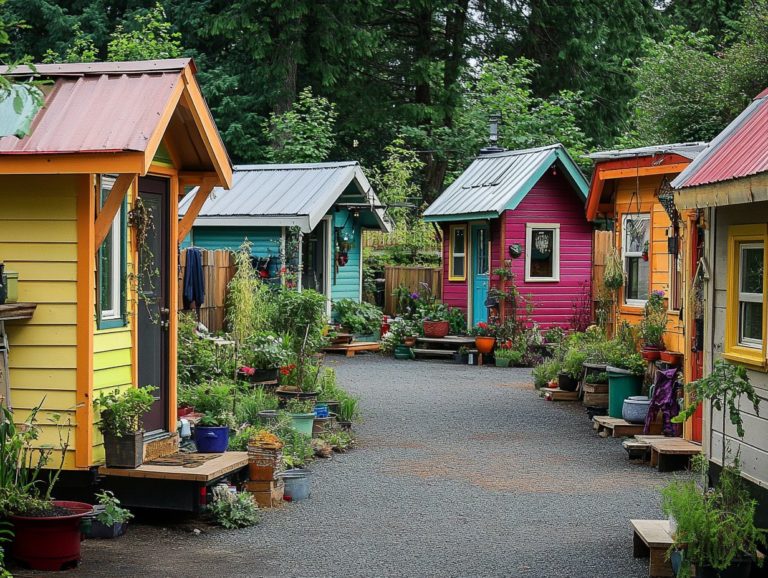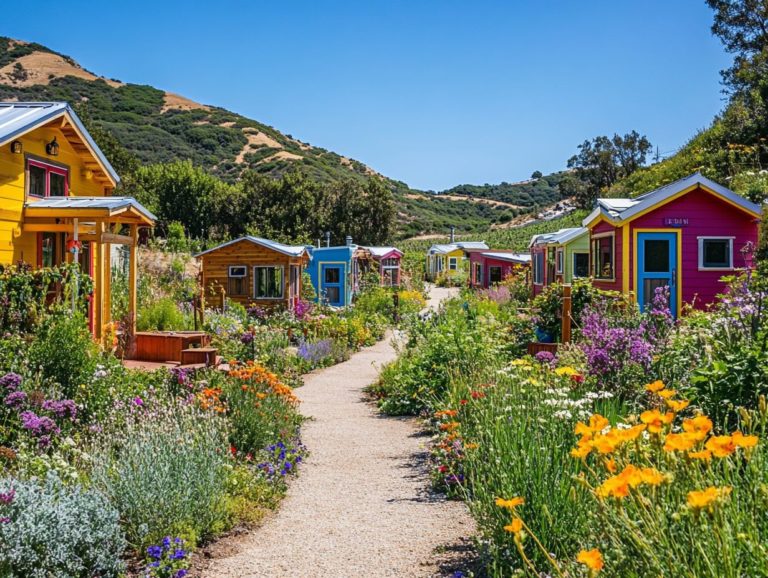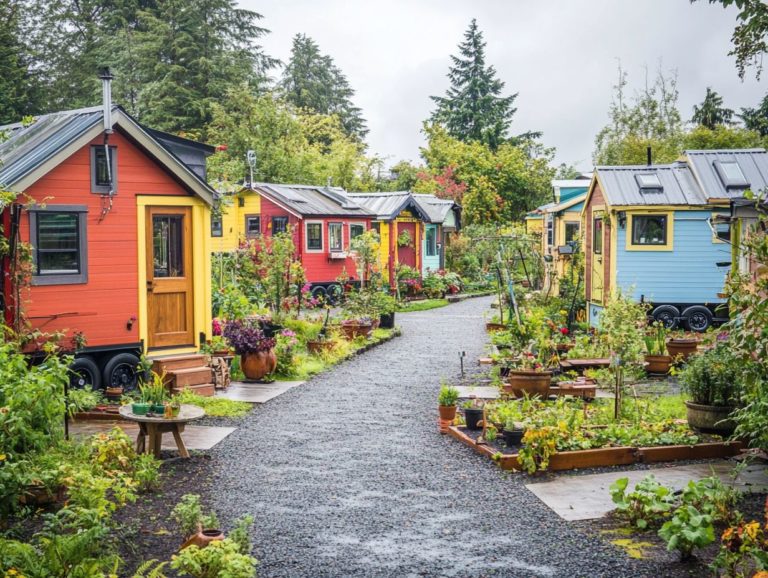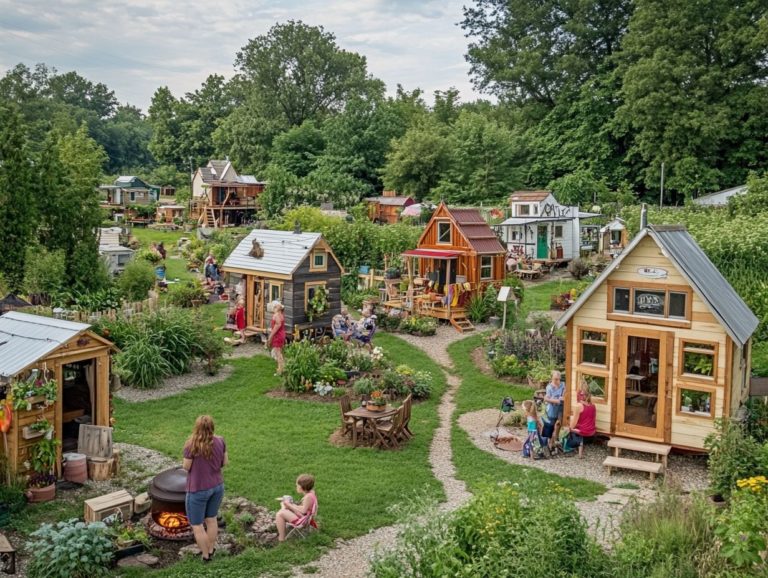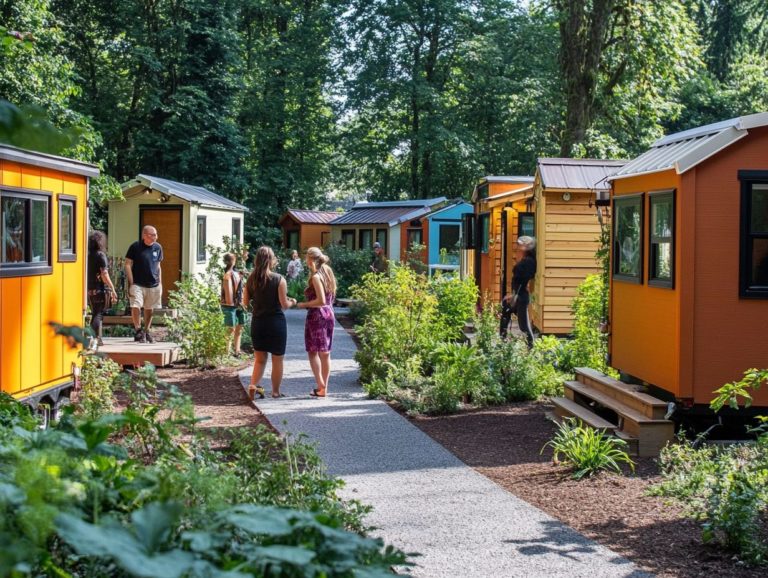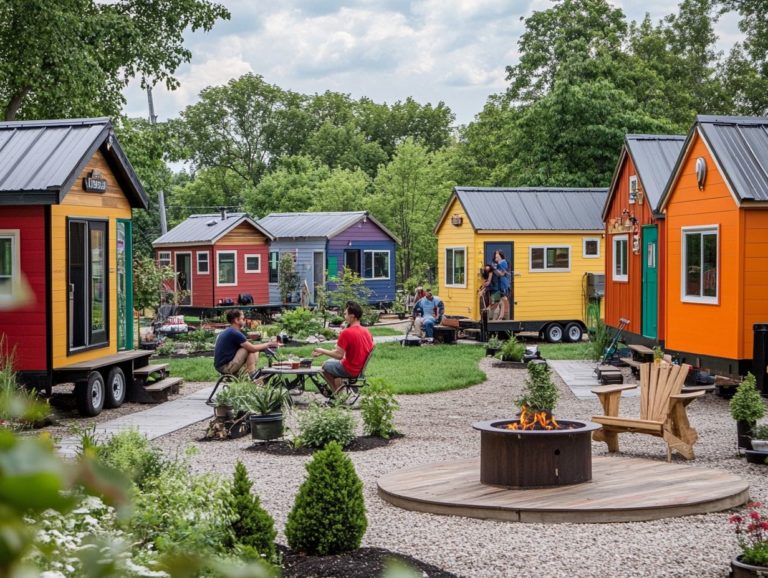Tiny House Communities: A Guide for Beginners
Imagine a lifestyle that embodies simplicity, sustainability, and a strong sense of community. Tiny house communities are emerging worldwide, presenting an innovative approach to living that emphasizes connection and environmental awareness.
This article delves into the essence of tiny house communities, highlighting their benefits and the various types available. Discover how you can join a tiny house community today! You’ll also find insights into common challenges and their solutions, along with resources to assist you on your tiny living journey.
Uncover the allure of downsizing and the vibrant community spirit that accompanies it!
Contents [hide]
Key Takeaways:
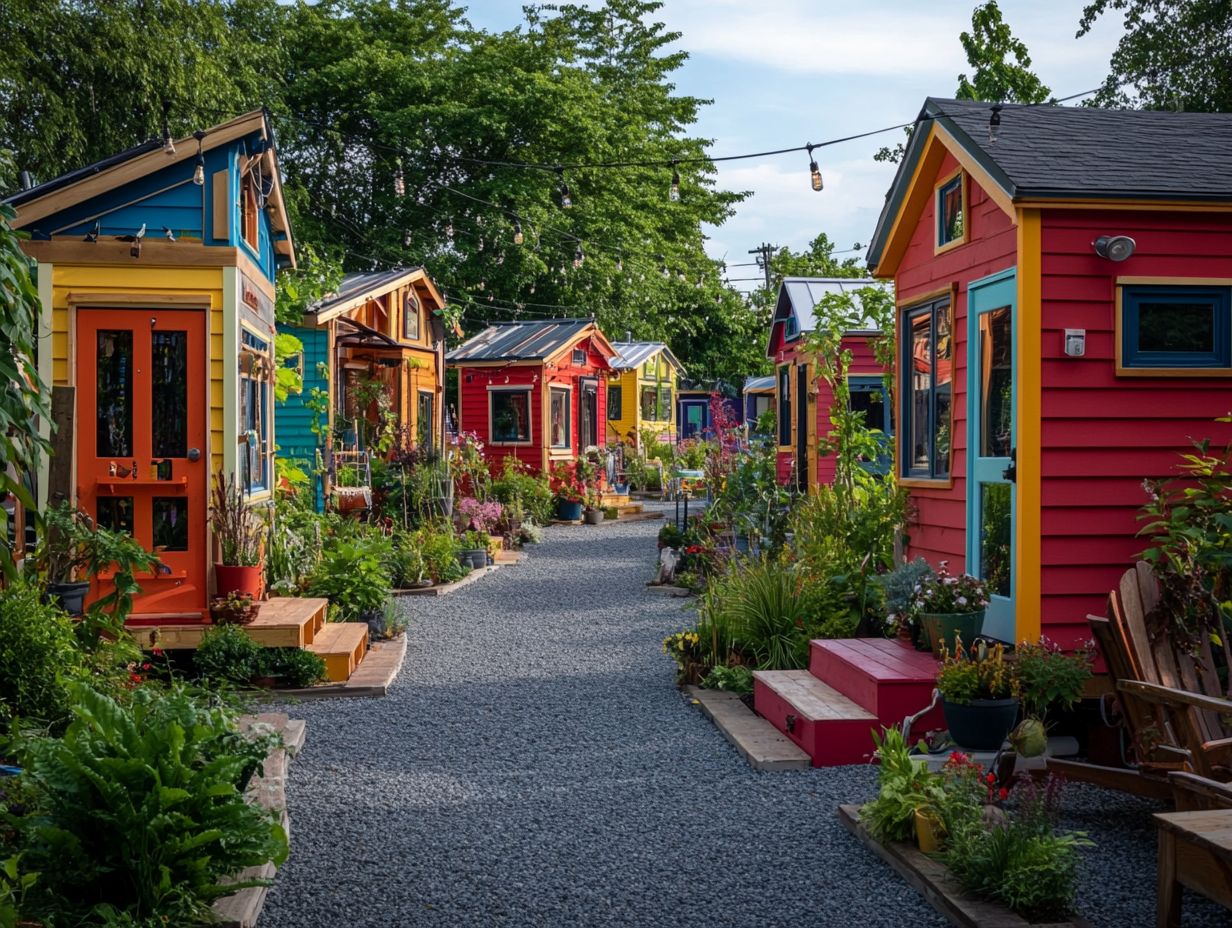
- Tiny house communities are intentional neighborhoods made up of small, eco-friendly homes that promote a simpler and more sustainable way of living.
- Living in a tiny house community can offer benefits such as reduced expenses, a sense of community, and a smaller environmental footprint.
- There are various types of tiny house communities, including intentional communities, co-housing communities, and RV parks, each with its own set of rules and regulations for living.
What are Tiny House Communities?
Tiny house communities represent a smart way to live today, crafted for individuals and families who aspire to a minimalist lifestyle while embracing sustainable principles.
Within these thoughtfully designed spaces, tiny houses typically ranging from 100 to 400 square feet foster a sense of belonging and shared values among residents, often reflecting the principles found in tiny house communities: an eco-friendly lifestyle.
By prioritizing space-saving designs and eco-friendly choices, these communities contribute to the broader tiny house movement. They also offer a compelling alternative to traditional housing options, such as tiny house communities. This approach effectively addresses the increasing demand for affordable housing solutions.
Defining the Concept
The concept of tiny houses centers on efficient living within compact spaces, often featuring innovative designs and multifunctional furniture (furniture that serves multiple purposes) that truly optimize every inch of their dimensions.
This minimalist approach fosters a sense of tranquility and encourages a meaningful lifestyle grounded in intentionally chosen possessions.
By prioritizing simplicity and functionality, these compact dwellings often incorporate clever storage solutions, convertible spaces, and open floor plans, enabling you to maximize your environment without feeling boxed in.
For example, the blueprints for models like the 20-foot THOW (Tiny House on Wheels) demonstrate how lofted beds (beds raised off the ground to create space below) can free up valuable floor space, while foldable tables can seamlessly adapt to various needs. Living in tiny house communities also fosters unique social interactions that enhance the experience.
In a world where clutter can easily become overwhelming, embracing the principles of tiny living cultivates a decluttered mindset. This promotes sustainability and a focus on experiences over material wealth, as highlighted in understanding the dynamics of tiny house communities.
Benefits of Living in a Tiny House Community
Living in a tiny house community presents a wealth of advantages that you might find irresistible. You can enjoy significant financial savings, embrace environmental sustainability, and cultivate a profound sense of community engagement with your neighbors.
These elements enhance the allure of this choice, making it an increasingly popular option for many.
Advantages for Individuals and the Environment
The benefits of living in a tiny house community go beyond just boosting your finances; they also play a pivotal role in sustainable living and environmental conservation.
When you choose to reside in these compact spaces, you often opt for energy-efficient designs that cut down on energy consumption without compromising comfort. Features like solar panels are commonly integrated, allowing you to harness renewable energy while reducing your carbon footprint. Additionally, becoming part of a tiny house community can enhance your living experience through valuable connections.
Rainwater collection systems provide excellent water management, underscoring the importance of conserving essential resources. Act now to diminish your ecological impact and inspire others!
This mindful lifestyle not only diminishes your ecological impact but also cultivates a sense of social responsibility within the community. As you and others embrace these eco-friendly choices, you inspire those around you, creating a ripple effect that enhances community well-being and fosters a healthier environment for generations to come.
Types of Tiny House Communities
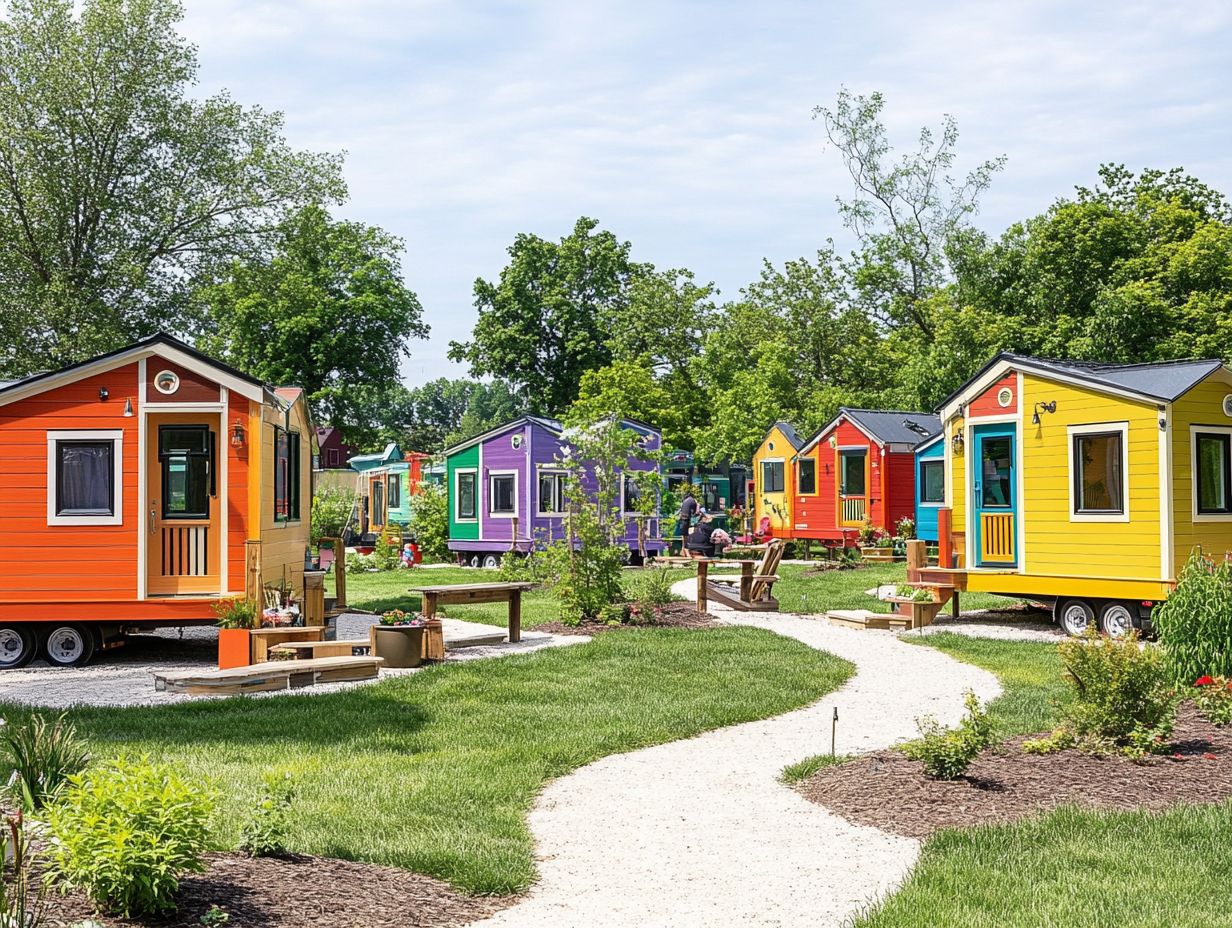
Tiny house communities present various options, including shared living arrangements and mobile tiny house parks, as well as permanent residential spaces for individuals or families.
Each type offers a unique mix of community and personal space. This allows you to select a setting that aligns with your lifestyle and values.
Exploring Different Models
Tiny house models suit different preferences and budgets. You can choose from DIY kits or custom builds by professional builders.
Each option has its own benefits and challenges, so it’s important to evaluate your priorities carefully. If you enjoy hands-on projects and want to add your personal touch, DIY kits may be ideal. For example, the popular Tumbleweed Tiny House allows for extensive customization. Additionally, if you’re considering community living, check out tips for new residents in tiny house communities.
Conversely, if you re short on time, hiring skilled builders can yield beautiful results with minimal hassle. Consider models like the Escape Trailer, known for its sleek design and practical layouts.
Many tiny homes also promote a sense of community. You can share resources and build connections while still enjoying flexible designs for lofts, multipurpose furniture, or outdoor spaces that enhance your living experience.
How to Join a Tiny House Community
Joining a tiny house community takes a thoughtful approach. Begin by exploring options that fit your lifestyle.
Understanding zoning laws is essential, as these can greatly affect where you can place your tiny home. Exploring tiny house financing options will also help in making a smoother transition.
Steps and Considerations
Before you dive into tiny house ownership, assess your lifestyle preferences, community values, and local tiny house regulations to ensure a harmonious fit.
It s also crucial to immerse yourself in the community culture. Understanding the available resources and support systems can make a significant difference.
Reach out to current residents for invaluable insights into daily life in a tiny house community. Engaging with them will help you understand how communal living is organized, from shared amenities to social events.
Building relationships with existing members grants you access to practical advice, tips for maximizing your space, and creative solutions for the common challenges of tiny living.
Challenges and Solutions for Tiny House Communities
Living in a tiny house community comes with exciting benefits, but it also presents unique challenges. You ll navigate building codes and regulations while fostering a supportive environment among your neighbors.
Addressing Common Issues
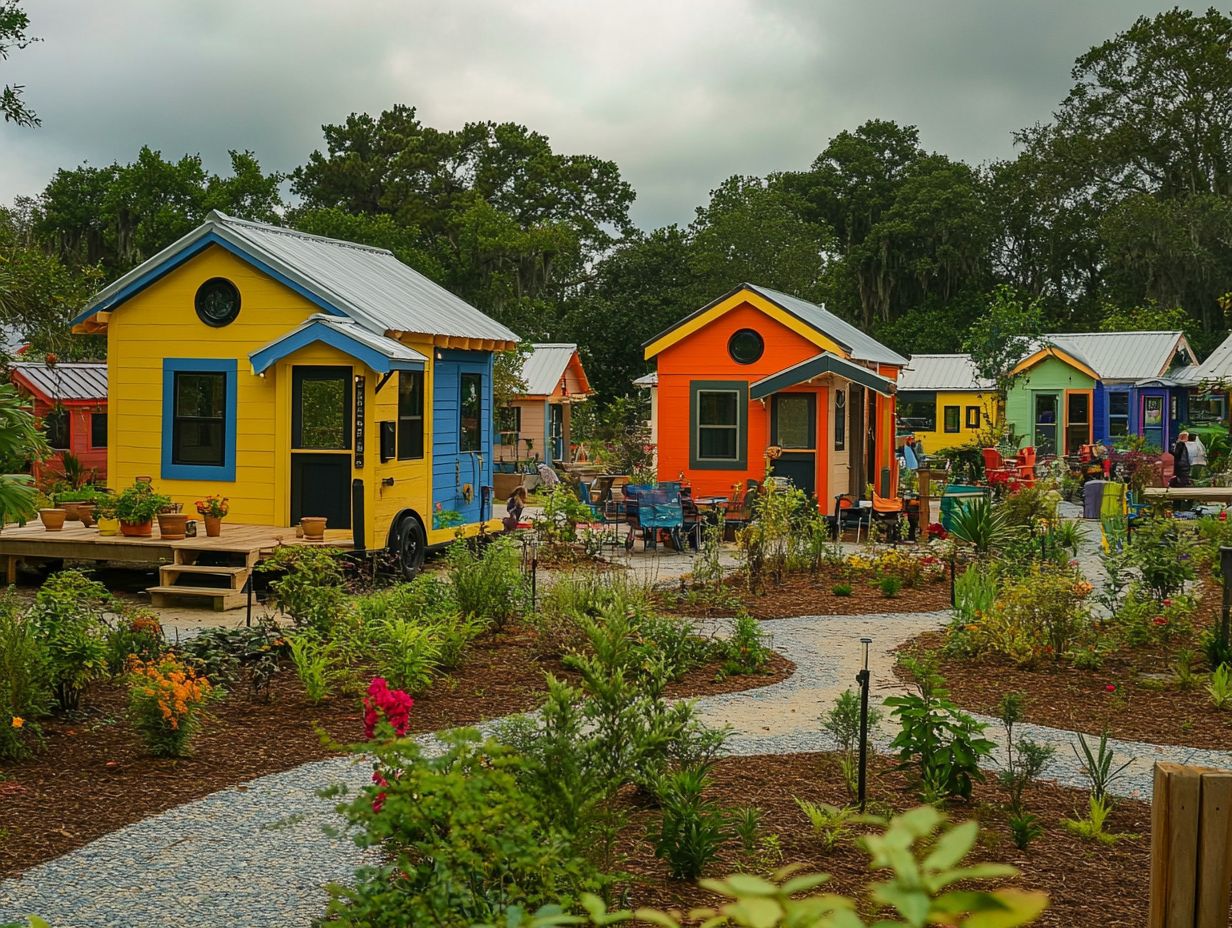
Addressing common issues in tiny house communities requires proactive measures. You should adhere to tiny house regulations, encourage community engagement, and implement sustainable practices for harmonious living.
Challenges like limited space, shared resources, and differing expectations regarding communal responsibilities may arise. By establishing clear guidelines for community involvement, you and your neighbors can create a more organized and cooperative environment, much like those found in tiny house communities that focus on building new friendships.
Engaging in collective initiatives such as community gardens or shared tool libraries can cultivate unity and promote sustainable practices. Additionally, exploring options like tiny house communities can be a solution to housing crises. Regular meetings where you and your neighbors can voice concerns and share ideas will enhance transparency and collaboration.
This approach ultimately improves the quality of life for everyone involved. Such collective efforts not only enhance daily functionality but also strengthen the social fabric of your tiny house community, so it’s important to be aware of the tiny house community rules you should know.
Resources for Tiny House Community Living
A wealth of resources awaits you if you’re exploring the enriching lifestyle of tiny house community living. From dedicated advocacy organizations to vibrant online platforms, you’ll find ample opportunities for community engagement and valuable insights.
Useful Organizations and Websites
Various organizations and websites offer invaluable tools for those looking to join or create tiny house communities. They assist with everything from grant applications to establishing community gardens.
For instance, the American Tiny House Association offers important information about zoning rules, which are the regulations regarding how land can be used. Websites like Tiny House Talk and Tiny House Listings connect you with like-minded enthusiasts, facilitating networking opportunities and support systems. Additionally, you can explore unique tiny house communities around the world for inspiration and ideas.
Crowdfunding platforms such as GoFundMe and Indiegogo allow you to raise funds collaboratively for your tiny house projects. Community gardens help build connections by providing shared spaces for crops and ideas, fostering a spirit of collaboration among neighbors.
Frequently Asked Questions
Curious about tiny house living? Here are some common questions answered!
1. What exactly is a tiny house community?
A tiny house community is a group of small homes, typically less than 400 square feet, built on a shared plot of land. These communities often have shared amenities and a strong sense of community among residents.
2. Are tiny house communities legal?
Wondering if tiny house communities are legal? It all depends on where you are. The legality varies based on local zoning laws. It’s important to do your research and ensure that the community you are interested in complies with all relevant regulations.
3. Can anyone live in a tiny house community?
While tiny house communities are generally open to anyone, some may have specific requirements or restrictions, such as age or income limits. It s best to check with the specific community for their eligibility criteria.
4. How much does it cost to live in a tiny house community?
The cost of living in a tiny house community can vary greatly based on location, amenities, and community size. Some may have monthly or yearly fees, while others might require you to purchase or rent a plot of land. Researching these costs is essential before committing.
5. What are the benefits of living in a tiny house community?
Living in a tiny house community offers many benefits, including a smaller environmental footprint, a lower cost of living, and a strong sense of community support. It can also help simplify your life and encourage you to downsize your belongings.
6. How can I find and join a tiny house community?
There are several ways to find and join a tiny house community. You can search online for nearby communities, attend tiny house events and conferences, or connect with other tiny house enthusiasts through social media. It’s important to visit and get to know the community before committing to living there.
Start your tiny house journey today find a community that feels like home!

